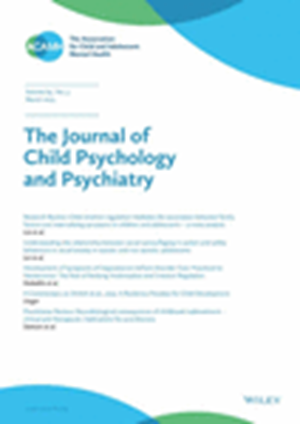儿童期至青年期心理和心脏代谢健康的纵向共同发展
IF 7
1区 医学
Q1 PSYCHIATRY
引用次数: 0
摘要
背景:抑郁症状和心脏代谢危险因素经常同时发生。然而,我们对它们共同发展的潜在机制和时间动力学的理解仍然难以捉摸。方法:这项基于人群的队列研究使用来自ALSPAC研究的前瞻性数据,研究了10 - 25岁抑郁症状与心脏代谢危险因素之间的双向纵向关联。每个结果至少有一个(或六个)随访测量的参与者被纳入分析。我们通过自我报告和父母报告来测量抑郁症状,并评估了几个心脏代谢危险因素(包括肥胖测量、脂质谱和炎症)。在我们的7,970名参与者(47%男性,96%白人)中,我们发现在整个研究期间,自我报告的抑郁症状和肥胖(即脂肪/瘦质量指数,但不是身体质量指数)之间存在双向的人内关联。与抑郁症状(0.26[0.12;0.38])相比,肥胖随着时间的推移更加稳定(β[范围]= 0.75[0.54;0.84]),与抑郁症状与未来肥胖之间的关联(0.07[0.03,0.13])相比,肥胖与未来抑郁症状之间的关联(0.04[0.03,0.06])具有更强的前瞻性(即交叉滞后)。这些关联的程度在14岁至16岁之间达到顶峰。我们没有发现抑郁症状与腰围、胰岛素、甘油三酯、低密度脂蛋白胆固醇或C反应蛋白之间存在双向交叉关联的证据。结论:这些发现提示抑郁症状与心脏代谢危险因素,特别是肥胖(即脂肪/瘦肉质量)之间存在双向关系。肥胖与未来抑郁症状的前瞻性关联较强;然而,他们的关系比之前认为的更加互惠。本文章由计算机程序翻译,如有差异,请以英文原文为准。
Longitudinal co‐development of mental and cardio‐metabolic health from childhood to young adulthood
BackgroundDepressive symptoms and cardio‐metabolic risk factors often co‐occur. However, our understanding of the potential mechanisms and temporal dynamics underlying their co‐development remains elusive.MethodsThis population‐based cohort study examined bidirectional longitudinal associations between depressive symptoms and cardio‐metabolic risk factors from age 10 to 25 years, using prospective data from the ALSPAC Study. Participants with at least one (of six) follow‐up measurement for each outcome were included in the analyses. We measured depressive symptoms through self‐ as well as parent‐reports, and assessed several cardio‐metabolic risk factors (including adiposity measures, lipid profiles, and inflammation).ResultsAmong our 7,970 (47% male, 96% White) participants, we found bidirectional, within‐person associations between self‐reported depressive symptoms and adiposity (i.e., fat/lean mass index, but not body mass index), across the study period. Adiposity was more stable over time (β [range] = 0.75 [0.54; 0.84]), compared to depressive symptoms (0.26 [0.12; 0.38]), and it had a stronger prospective (i.e., cross‐lagged) association with future depressive symptoms (0.07 [0.03, 0.13]) compared to that between depressive symptoms and future adiposity (0.04 [0.03, 0.06]). The magnitude of these associations reached its peak between 14 and 16 years. We did not find evidence of cross‐lagged associations in either direction between depressive symptoms and waist circumference, insulin, triglycerides, LDL cholesterol, or C‐reactive protein.ConclusionsThese findings suggest a bidirectional relationship between depressive symptoms and cardio‐metabolic risk factors, particularly adiposity (i.e., fat/lean mass). Adiposity showed a stronger prospective association with future depressive symptoms than vice versa; however, their relationship revealed more reciprocal than previously thought.
求助全文
通过发布文献求助,成功后即可免费获取论文全文。
去求助
来源期刊
CiteScore
13.80
自引率
5.30%
发文量
169
审稿时长
1 months
期刊介绍:
The Journal of Child Psychology and Psychiatry (JCPP) is a highly regarded international publication that focuses on the fields of child and adolescent psychology and psychiatry. It is recognized for publishing top-tier, clinically relevant research across various disciplines related to these areas. JCPP has a broad global readership and covers a diverse range of topics, including:
Epidemiology: Studies on the prevalence and distribution of mental health issues in children and adolescents.
Diagnosis: Research on the identification and classification of childhood disorders.
Treatments: Psychotherapeutic and psychopharmacological interventions for child and adolescent mental health.
Behavior and Cognition: Studies on the behavioral and cognitive aspects of childhood disorders.
Neuroscience and Neurobiology: Research on the neural and biological underpinnings of child mental health.
Genetics: Genetic factors contributing to the development of childhood disorders.
JCPP serves as a platform for integrating empirical research, clinical studies, and high-quality reviews from diverse perspectives, theoretical viewpoints, and disciplines. This interdisciplinary approach is a key feature of the journal, as it fosters a comprehensive understanding of child and adolescent mental health.
The Journal of Child Psychology and Psychiatry is published 12 times a year and is affiliated with the Association for Child and Adolescent Mental Health (ACAMH), which supports the journal's mission to advance knowledge and practice in the field of child and adolescent mental health.

 求助内容:
求助内容: 应助结果提醒方式:
应助结果提醒方式:


